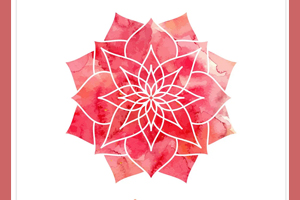In our previous articles, we talked about AyurYoga and got to know Ayurveda, the Vata Dosha, and the Pitta Dosha.
So how about today, we spend some time getting to know the Kapha Dosha— slowly, calmly, and with presence?
In Ayurveda, the five main elements of nature within the body and mind are explained through three organizing principles called Doshas: Vata, Pitta, and Kapha.
The third dosha, Kapha, is made up of the elements earth and water.
It is cold, moist, heavy, oily, dense, and cohesive. Kapha governs growth, stability, and the maintenance of moisture in the body. The water element in Kapha lubricates the joints and tissues, while the earth element provides structure, form, and endurance — building bones, muscles, and the body’s frame.
Some people are born with a naturally dominant Kapha constitution — their Prakriti. Others develop an excess of Kapha through poor diet or lifestyle habits.
In Ayurveda, when we say a dosha is “out of balance,” it means that its qualities and elements have increased excessively in the body and mind.
Too much Kapha means an excess of earth and water, leading to coldness, heaviness, and dampness. Among the three doshas, Kapha is the most prone to stagnation when not balanced.
Physical Traits of Kapha Types
* Broad shoulders and a large, sturdy frame. Naturally strong and well-built, often with a tendency to gain weight easily.
* Skin is cool, oily, moist, and thick.
* Face is round, pale, and full, with plump cheeks and fewer wrinkles due to the richness of subcutaneous fat.
* Hair is thick, heavy, and oily.
* Eyes are large, with long lashes; eyelids (especially lower lids) may swell easily, and eyes tend to water.
* Nose is large with a rounded tip; they are prone to mucus buildup, postnasal drip, allergies, sinus issues, and colds.
* Tongue is large and pale, often with a thick white coating.
* Nails are strong, smooth, and round.
* Voice is deep, slow, and melodious.
* They sleep deeply and for long hours; waking up can be difficult, and they may feel drowsy during the day.
* Hands and feet are cold, and they prefer warmth and sunshine.
* Their digestion is slow and heavydue to excess moisture; they often feel full and can skip meals without discomfort.
Mental and Emotional Traits of Kapha Types
* Calm, loving, compassionate, and emotionally steady.
* Patient and peaceful — nothing easily disturbs them.
* They move and act slowly but steadily.
* When imbalanced, they may fall into **depression, apathy, or laziness**, become overly attached, and struggle with low motivation or self-confidence.
Common Kapha Imbalances
* Heaviness and fullness in the stomach
* Poor appetite
* Weight gain
* Mucus buildup, allergies, sinus congestion
* Slow metabolism
* Hypothyroidism
* Diabetes
* Water retention or swelling
* Depression and lethargy
* Excessive sleepiness
* Mental fog and forgetfulness
Key Ways to Balance Kapha Dosha
Kapha’s main qualities are coldness and moisture, so to restore balance, one should bring in warmth, dryness, and stimulation — in food, environment, and activity.
Dietary Guidelines
If your dominant dosha is Kapha or you’re experiencing Kapha imbalance, reduce foods that are heavy, cold, or damp, and favor warm, dry, and light foods.
Avoid or limit:
* Sweet foods: Most sweet foods (except honey, apples, pears, and beets) increase Kapha. Limit dates, figs, bananas, grapes, and melons. Avoid sugar and use natural light sweeteners like honey, apple syrup, or maple syrup.
* White flour products: Bread, pasta, pastries, cakes, and biscuits — they are heavy and mucus-forming. Choose whole-grain, multigrain, or gluten-free alternatives.
* Dairy products from cows — milk, yogurt, cream, butter, and cheese are heavy and clogging. Replace them with lighter options like goat milk or plant-based alternatives (almond or coconut milk).
* Desserts, sweets, and cold foodssuch as ice cream should be avoided.
* Meats like beef, pork, and processed meats are too heavy. Limit red meat and opt for small portions of light proteins.
* Fried and oily foods, fast food, chocolate, pickles, and salty snacks like chips.
* Sour and salty tastes in excess, as well as heavy nuts like peanuts and cashews.
* Caffeine may seem energizing at first, but in the long run, it weakens metabolism — replace it with herbal teas.
Favor:
* Warm, light, and spicy meals.
* Cooked vegetables like parsley, basil, spinach, beetroot, carrots, and greens. These act like natural sponges, absorbing excess moisture.
* Use digestive and warming spices such as turmeric, cumin, black seed, fennel, cinnamon, thyme, rosemary, saffron, and fresh ginger. They boost digestion and metabolism.
* Include more pungent (spicy), bitter, and astringent tastes.
* Keep dinner light — steamed vegetables or a warm salad are ideal. Avoid rice, bread, cheese, and yogurt at night.
* Every week or two, try a gentle detox or cleansing diet to reset your system.
Lifestyle Tips for Kapha Balance
* Avoid cold and damp environments; keep your head, neck, and ears warm in winter.
* Your body loves movement! Make physical activity a non-negotiable part of your daily routine.
Start your day with 6–12 rounds of Surya Namaskar (Sun Salutation) and Simhasana (Lion’s Pose.
Engage in cardio, jogging, or any exercise that makes you sweat for at least 20–30 minutes daily.
* Sleep less and rise before sunrise; avoid daytime naps.
* Massage your body with warming oils such as mustard, black seed, or ginger oil.
* Travel often and break repetitive routines — new experiences awaken Kapha energy.
* And of course, don’t forget meditation— it clears mental fog and awakens awareness.
Yoga for Balancing Kapha Dosha
If your Kapha is high — genetically or due to imbalance — you’re likely full of the earth and water elements. Think of a snowball, a sticky lump of clay, or a sleepy panda. Heavy, cool, and still.
In yoga, each posture carries certain energetic qualities — warming or cooling, heavy or light.
For Kapha types, it’s important to practice dynamic, energizing, and heating asanas that build internal fire (Agni) and awaken vitality.
Asanas that Stimulate Kapha
Since the fire element (Agni) resides in the navel and abdominal area, asanas that contract and twist the abdominal muscles ignite digestion and metabolism.
Recommended poses:
* Marjariasana (Cat Stretch)
* Surya Namaskar (Sun Salutation)
* Bharadvajasana (Simple Twist)
* Ardha Matsyendrasana I (Half Lord of the Fishes Pose)
* Marichyasana I, II, III (Marichi’s Pose)
Head-Related Poses for Stimulating the Pituitary Gland
On the crown of the head lie subtle Marma points — Murdhni, Brahmarandhra, and Shivarandhra* — connected to the pituitary gland, which governs metabolism through thyroid regulation.
Stimulating these points through inverted poses improves metabolism and ignites fire.
Recommended poses:
* Sirsasana (Headstand)
* Dwi Pada Viparita Dandasana (Two-Legged Inverted Staff Pose)
* Pincha Mayurasana (Forearm Stand)
Asanas for Reducing Mucus and Clearing the Upper Body
Kapha types tend to accumulate mucus in the chest and sinuses. Inversions and forward bends that help drain this buildup are excellent for them.
Recommended poses:
* Adho Mukha Svanasana (Downward-Facing Dog)
* Urdhva Prasarita Eka Padasana (Standing Split)
* Ardha Pincha Mayurasana (Dolphin Pose)
* Parsvottanasana (Pyramid Pose)
Other energizing postures:
* Virabhadrasana II & III (Warrior II & III)
* Parsvakonasana (Extended Side Angle Pose)
Pranayama for Kapha Balance
* Kapalabhati (Skull Shining Breath)
* Bhastrika (Bellows Breath)
* Surya Bhedana (Sun-Piercing Breath)
In breathing practice, emphasize longer, deeper exhalations— exhalation generates internal heat and activates metabolism, while inhalation cools.
Final Tips
Switch off your “inertia” button and turn on your energy and action mode.
Move your body every day — at least 20–30 minutes of yoga or movement to awaken your fire within.
May you be full of vitality, lightness, and health.
References:
* Yoga for Your Type: An Ayurvedic Approach to Your Asana Practice – David Frawley & Sandra Summerfield Kozak
* Ayurvedic Yoga Therapy – Mukunda Stiles





